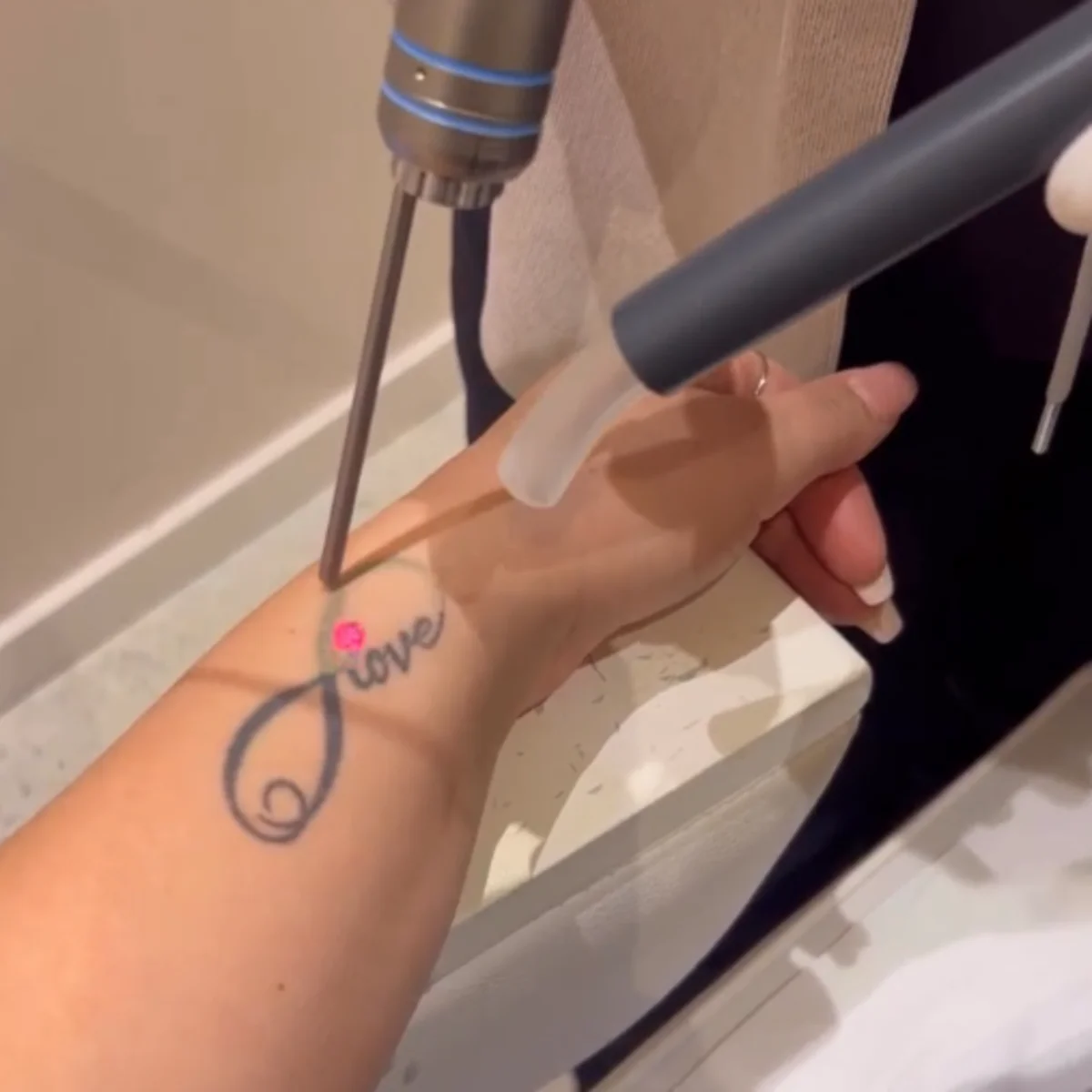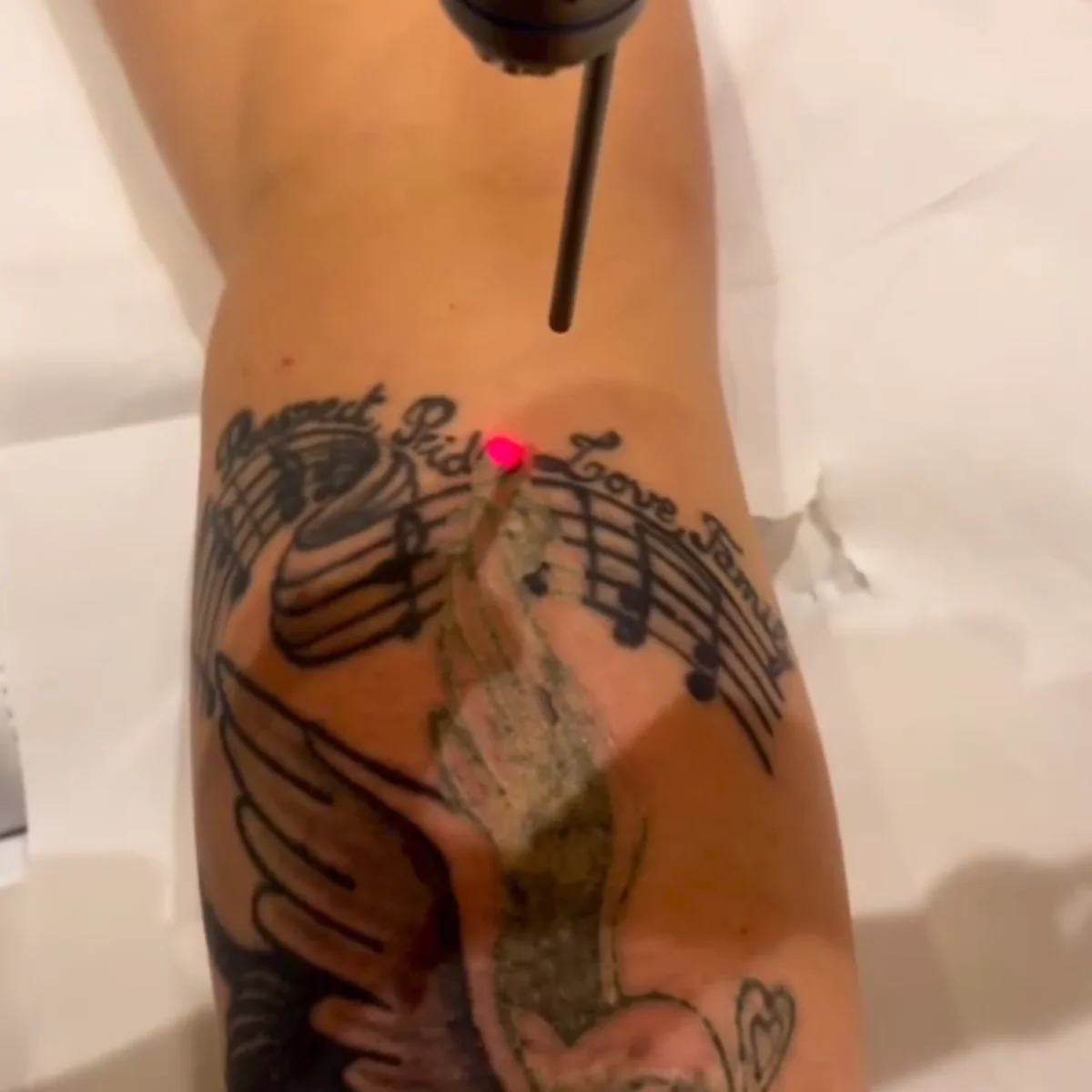Understanding the recovery duration between sessions and what to expect afterwards is essential for those new to laser tattoo removal near me. This information will help you better prepare for the process.

Proper aftercare is necessary
Following these aftercare instructions is crucial for achieving optimal results in tattoo removal. Laser therapy is the initial step in the process, and proper care before and after treatment is critical to achieving the best possible outcomes.
Maintaining general health before, during, and after laser treatment is vital to optimize the body's natural healing and ink clearance processes. Avoid or limit toxins like nicotine and alcohol, as they can burden the immune system. Stay active, drink plenty of fluids, and stimulate the lymphatic and vascular systems to assist in removing ink from your bloodstream.
What happens after laser treatment?
During laser tattoo removal near me, a whitening (or frosting) of the ink may occur due to the heat energy released from the laser breaking down the ink particles. This frosting is temporary, typically lasting only a few minutes, and will likely disappear when you leave the clinic.
After the frosting is removed, the skin may experience redness and heat, similar to sunburn. This sensation typically lasts for a few hours to a few days.
Swelling is a common reaction after laser treatments, as your body responds and tries to immobilize the treated area. Larger tattoos tend to. o experience more swelling than small tattoos. Poor circulation makes body parts like lower limbs and extremities more prone. Swelling may follow gravity and move downwards after treatment, but it is normal and will fade with time.
Bruising can occur on tattoos after laser removal, especially in sensitive areas like the ribs and inner biceps. This average side effect typically lasts up to 2 weeks and is not a cause for concern.
How to care for a tattoo after laser treatment?
Once you've wrapped up your session at our clinic and are ready to head out, your tattoo will be neatly covered with a calming gel and a sterile bandage. Sometimes, we might go with the gel, skipping the bandage. From there, here's what you should do:
- Give the treated area a good icing immediately after your appointment, and keep it up over the next 48 hours. Drawing the heat out of the area post-treatment is vital for smoother healing. Feel free to use ice packs (ensure they're covered) on top of the bandage or switch them out every 15 minutes. Once it is off, the tattoo is on your limb; keep that elevated while icing to reduce swelling and discomfort. The first 24 hours are crucial for minimizing swelling and easing any discomfort.
- The bandage should come off within a few hours, be it because the gel's leaked out, you're about to shower, or hit the sack – whichever comes first. A gentle wash with water will do post-bandage, and the area will be patted dry afterwards. Steer clear of soaps and lotions on the healing tattoo. Dab on some Aloe Vera gel twice daily for 48 hours to soothe and let the skin breathe, helping to fend off any itchiness. Keeping your Aloe Vera gel chilled will give you an extra soothing boost. There's no need for another bandage after the first one's off, but if your tattoo's in a spot that's getting irritated by clothing or footwear, putting a new bandage over some Aloe Vera Gel is okay – remember to change it as advised above.
- Resting and keeping your tattoo elevated during the first day post-treatment aids in healing and reduces discomfort and swelling. If you're feeling sore, over-the-counter painkillers like paracetamol are fine (follow the pack instructions), but try to avoid aspirin or ibuprofen to dodge any bleeding or bruising risks.
- You might notice some minor scabbing, which is normal. These tiny scabs, shaped like squares, are thanks to the fractional laser we use to help healing. They might feel rough, like sandpaper, and can stick around for up to two weeks in less-circulated areas. Let them fall off naturally for smooth skin underneath.
- A bit of weeping from the tattoo in the days after is standard, especially with larger ones. It's just the swelling finding its way out through the small holes made by the laser, helping to prevent blistering and aid healing. Just pat any webpage dry and bandage as needed to protect your clothing.
- Once your skin's healed and any scabs or crusts have vanished, a regular moisturizer, like Vitamin E, will keep your skin hydrated, ease itching, and support healing.
- Itching is pretty standard as your skin heals and starts to eject the ink particles – it could also be a sign of dehydration. Do not scratch; apply a moisturizing cream like Vitamin E and keep hydrated. A bit of 1% Hydrocortisone cream or oral antihistamines might be necessary for severe itching.
- Make-up is okay on the tattooed area once any open wounds have healed.
How to treat blisters from laser treatment?
Blistering may occur after laser treatment, a normal part of the healing process. It is common on large tattoos or areas with low circulation, like fingers and ankles. Blisters can be treated easily and healed with proper aftercare, leaving the skin intact.
If blisters form:
- It is recommended to avoid puncturing the affected area and to continue applying ice for up to 48 hours after treatment. This will help reduce discomfort and may aid in completely subsiding the issue.
- To treat popped blisters, apply antibacterial ointment or liquid multiple times daily and cover with a dressing or bandage. Repeat this process for at least 48 hours after the blisters have burst.
If there are any signs of crusting, scabbing, or oozing from the blisters:
- It is essential to avoid picking at or scraping the affected area to prevent infection and scarring. Shaving should be avoided until the area is fully healed.
- To treat the wound, apply antibacterial ointment or liquid multiple times daily and cover it with a dressing or bandage.
- Continue this daily until any crusting, scabbing, or oozing has cleared.
In rare cases, a tattoo may become infected following blisters. If you notice signs of infection, such as a temperature over 38°C, increasing pain, honey-coloured oozing, or increasing redness running away from the area, contact us immediately or visit your local doctor or medical centre.
Follow post-laser tattoo removal care guidelines.

- Steer clear of too much warmth on your skin (like hot baths, saunas, spas, or heated yoga sessions) for at least a few days post-treatment. This advice also extends to your workplace, especially if it's a hot spot like a commercial kitchen, bakery, or anything of that sort. Keep your healing ink as shielded from heat as possible to lower the risk of blisters. Remember, it might take 48 hours for your body to cool down after getting laser work done on big tattoos.
- While your tattoo is still healing and showing scabs, avoiding dunking it in baths, saunas, spas, pools, or the sea is best. However, a quick dip or surf session is alright, provided you dodge the sun, dab your tattoo dry gently afterwards, and follow any other advice.
- Showering on the day you get treated is fine, but keep away from super hot or strong jets of water directly on your tattoo. In the first two days following your session, chuck some ice on your tattoo after showering and slap on some Aloe Vera gel again.
- Avoid sunbaking directly or for too long throughout the healing and treatment period, particularly in the first month post-treatment. Healing from laser treatment is like getting over a sunburn, so copping another sunburn on top is a rotten idea. Sunbaking increases the blistering risk and might lead to dodgy skin colour changes (either too dark or too light). And yep, this includes sunbeds, spray tans, tanning injections, and other fake baking methods. If there's no dodging the sun after treatment, either cover your tattoo with clothing or slap on some SPF50+ sunscreen to keep it as fair dinkum pale as possible for better results each session.
- Give a wide berth to any hard yakka in the first 48 hours post-treatment to let your body cool down and keep blisters and swelling at bay. Light exercise is alright; remember to ice your tattoo again afterwards. The bigger your tattoo, the more crucial this is.
- And lastly, avoid knocking or scraping your tattoo at any time, before or after your treatments. The better you treat your skin throughout this laser removal rigmarole, the happier you'll be with the outcome.